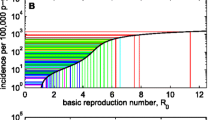Summary
Although Wade Hampton Frost was not the first to develop cohort analysis, it was the post-humous publication of his study of age and time trends of tuberculosis mortality that directed attention to this method of analysis. Frost's developing interest in and contributions to the epidemiology of chronic disease are reviewed in connection with a summary of his professional career.
Zusammenfassung
Obwohl Wade Hampton Frost nicht der erste war, der die Kohortenanalyse entwickelte, war es die posthume Veröffentlichung seiner Studie zu Alter und Zeittrends von Tuberkulose-Mortalität, die die Aufmerksamkeit für diese Analysemethode auf sich zog. Frosts fortschreitendes Interesse an und seine Beiträge zur Epidemiologie von chronischen Krankheiten werden in diesem Artikel zusammen mit einem Überblick über seine berufliche Karriere nachgezeichnet.
Résumé
Bien que Wade Hampton Frost ne fut pas l'inventeur de l'analyse de cohorte, c'est la publication posthume de son étude sur les tendances temporelle et selon l'âge des décès par tuberculose qui a attiré l'attention sur ce type d'analyse. Cet article montre le lien entre la carrière professionnelle de Frost, son intérêt croissant et sa contribution a l'épidémiologie des maladies chroniques.
Similar content being viewed by others
References
Maxcy KF, ed. Papers of Wade Hampton Frost, M.D. A contribution to epidemiological method. New York: The Commonwealth fund, 1941. (This is the major source of material for this article).
Kasius RV, ed. The challenge of facts. Selected public health papers of Edgar Sydenstricker. New York: Prodist, 1974.
Frost WH. The importance of epidemiology as a function of health departments. Medical Officer (London), 1923;23: 113–4.
Frost WH. Epidemiology. Nelson Loose-Leaf System, Public Health-Preventive Medicine. Volume 2, Chapter 7. New York: Thomas Nelson & Sons, 1927. [Reprinted in (1).]
Fee E. Disease and discovery. A history of the Johns Hopkins School of Hygiene and Public Health, 1916–1939, Baltimore: The Johns Hopkins Press, 1987.
Linder FE, Grove RD. Vital statistics rates in the United States, 1900–1940. Washington: U.S. Government Printing Office, 1947.
U.S. Public Health Service, Division of Public Health Methods and Tuberculosis Control Division. Tuberculosis in the United States, graphic presentation. Vol 2: Proportionate mortality statistics for states and geographic divisions by age, sex and race. Washington: Medical Research Committee, National Tuberculosis Association, 1944.
Puffer RR. Familial susceptibility to tuberculosis. Cambridge, MA: Harvard University Press, 1946.
Zeidberg LD, Gass RG, Dillon A, Hutcheson RH. The Williamson County Study. A twenty-four-year epidemiologic study. Am Rev Respir Dis 1963;87(No. 3 Part 2): 1–88.
Frost WH. Risk of persons in familial contact with pulmonary tuberculosis. Am J Public Health 1933;23:426–32.
Elderton WP, Perry SJ. Drapers' Company Research Memoirs. Studies in National Deterioration. VI: A third study of the statistics of pulmonary tuberculosis. The mortality of the tuberculous and sanatorium treatment. London: Cambridge University Press, 1910.
Weinberg W. Die Kinder der Tuberkulosen. Leipzig: Hirzel, 1913.
Brown L, Pope EG. The postdischarge mortality among the patients of the Adirondack Cottage Sanitarium. Am Med 1904;8: 879–82.
Putnam P. Tuberculosis incidence among white persons and negroes following exposure to the disease. Am J Hyg 1936;24: 536–51.
Downes J. A study of the risk of attack among contacts in tuberculous families in a rural area. Am J Hyg 1935;22: 731–42.
Cassedy JH. Charles V. Chapin and the Public Health Movement. Cambridge, MA: Harvard University Press, 1962.
Frost WH. The age selection of mortality from tuberculosis in successive decades. Am J Hyg 1939;30: 91–6. (Reprinted in Am J Epidemiol 1995;141: 4–9).
Frost WH. How much control of tuberculosis? Am J Public Health 1937;27: 759–66.
Andvord KF. Hvad kan vi laere ved a folge tuberkulosens gang fra generasjon til generasjon? Norsk Magasin Laegevidenskapen 1930;91: 642–60. (Engl. transl. by Gerard Wijsmuller).
Comstock GW. Early studies of tuberculosis. National Cancer Institute Monograph 67. Selection, follow-up, and analysis in prospective studies: a workshop. Washington: U.S. Government Printing Office, 1985. (NIH Publication No. 85-2713).
Frost WH. The outlook for the eradication of tuberculosis. Am Rev Tuberc 1935;32: 644–50.
National Tuberculosis Association, Committee on Diagnostic Standards. Diagnostic standards and classification of tuberculosis. 1940 edition, New York: National Tuberculosis Association, 1940.
American Thoracic Society, Committee on Revision of Diagnostic Standards. Diagnostic standards and classification of tuberculosis, New York: National Tuberculosis and Respiratory Disease Association, 1969.
Author information
Authors and Affiliations
Rights and permissions
About this article
Cite this article
Comstock, G.W. Cohort analysis: W.H. Frost's contributions to the epidemiology of tuberculosis and chronic disease. Soz Präventivmed 46, 7–12 (2001). https://doi.org/10.1007/BF01318793
Issue Date:
DOI: https://doi.org/10.1007/BF01318793




